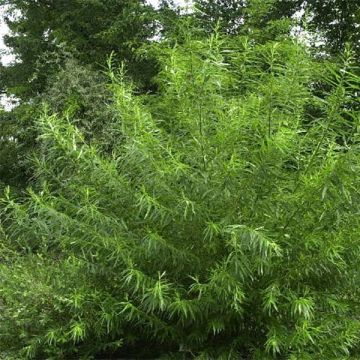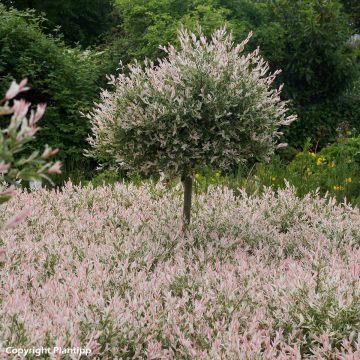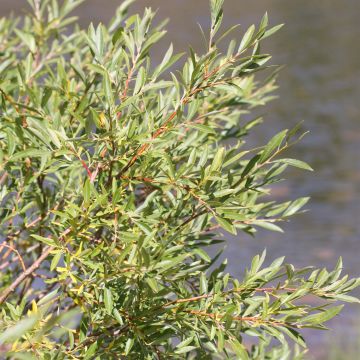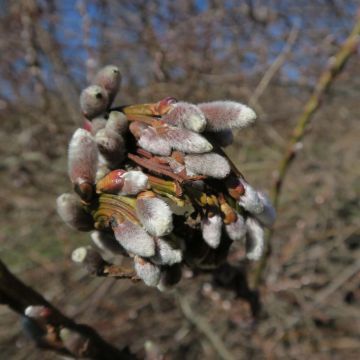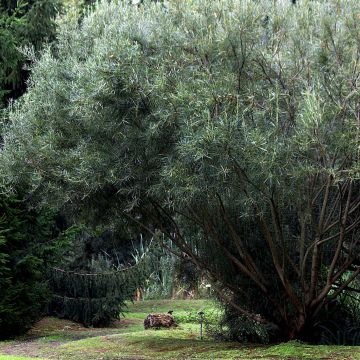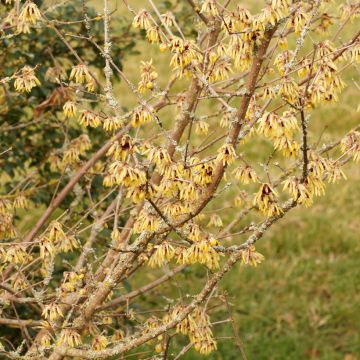Shipping country and language
Your country of residence may be:
Your country of residence is:
For a better user experience on our website, you can select:
Your shipping country:
Andorra
Austria
Belgium
Bulgaria
Canada
Chile
Croatia
Cyprus
Czechia
Denmark
Estonia
Finland
France
Germany
Greece
Hungary
Iceland
Ireland
Italy
Latvia
Lithuania
Luxembourg
Malta
Monaco
Netherlands
Poland
Portugal
Romania
Slovakia
Slovenia
Spain
Sweden
Switzerland
United Kingdom
We only deliver seed and bulb products to your country. If you add other products to your basket, they cannot be shipped.
Language:
French
German
Spanish
English
My Account
Hello
My wish lists
Plantfit
Log in / Register
Existing customer?
New customer?
Create an account to track your orders, access our customer service and, if you wish, make the most of our upcoming offers.


Salix alba - White Willow


Salix alba - White Willow


Salix alba - White Willow
Salix alba - White Willow
Salix alba
White Willow
Why not try an alternative variety in stock?
View all →Order in the next for dispatch today!
Dispatch by letter from €3.90.
Delivery charge from €5.90 Oversize package delivery charge from €6.90.
More information
This item is not available in your country.
Schedule delivery date,
and select date in basket
This plant carries a 24 months recovery warranty
More information
We guarantee the quality of our plants for a full growing cycle, and will replace at our expense any plant that fails to recover under normal climatic and planting conditions.
From €5.90 for pickup delivery and €6.90 for home delivery
Express home delivery from €8.90.
From €5.90 for pickup delivery and €6.90 for home delivery
Express home delivery from €8.90.
From €5.90 for pickup delivery and €6.90 for home delivery
Express home delivery from €8.90.
Does this plant fit my garden?
Set up your Plantfit profile →
Description
Yellow Wood Willow, in Latin Salix alba, is a variety of White Willow whose golden branches have been curved and joined together to form a charming high aviary. Crowned with beautiful shiny foliage in spring and summer, the bright yellow young branches of this osier are particularly revealed under the pale winter sun, in a more ochre but shiny yellow tone. More hardy and less invasive than bamboo, this bush takes up little space on the ground and can compete with it in elegance and flexibility, whether as a standalone specimen, in a green room or in a large pot on the terrace. It grows in full sun, in any deep garden soil, simply remaining slightly moist or more distinctly damp. Its maintenance consists of pruning misplaced twigs in winter and reducing its growth with a short pruning.
Native to wet areas of Europe, temperate Asia and North Africa, Salix alba is a highly adaptable and fast-growing tree, reaching up to 20m (65 ft 7in) in height and 10m (32 ft 10in) in spread if not pruned. It belongs to the family Salicaceae and the genus Salix, which includes no less than 300 species distributed in the cold regions of the Northern Hemisphere. Its habit is generally rounded, with the tree developing one or several trunks topped with a wide crown. The long flexible branches of this willow have the ability to twist and root very easily, allowing creative gardeners and horticulturists to shape it according to their desires. It is often cultivated in the form of a "pollard" for basketry production. Some cultivars and varieties derived from this willow have been selected for the beautiful coloration of their bark.
Yellow Wood Willow should be regularly pruned if one does not want it to reach 10m (32 ft 10in) in height. The long flexible branches are pubescent when young, then they take on a beautiful bright yellow colour. They bear deciduous to semi-evergreen leaves in winter, 10cm (3.9in) long, narrow and lanceolate in shape. Both sides of the leaf blade are silky, with the upper side being shiny and deep green, and the lower side silver-white. Flowering occurs in April-May, at the same time as the young leaves appear. It is a dioecious tree, with male and female subjects. The male catkins are slender, 3 to 5cm (2in) long, arched and spread out, yellowish in colour. The female catkins are smaller, denser and green in colour. The bark of this tree becomes more brown and fissures longitudinally with age. Its powerful root system, both taprooted and extensively spreading, is perfectly adapted to deep and unstable soils. For this reason, it is advisable to keep this willow away from pipes. White willow is also a medicinal plant, with the bark being the first source of aspirin. Salix alba can reach the venerable age of 100 years.
Place your domed Yellow Wood Willow in a strategic location in the garden, as a standalone specimen or in groups of 3 subjects. Also, place it in a carefully chosen large pot on the terrace or balcony, monitoring the watering: it will have a great effect and earn you compliments from your visitors! You can also plant several subjects in a row or as a clump, to form a graphic hedge that will delimit a vegetable square or elegantly hide your compost, clotheslines, a small tool shed, etc. The golden stems of this willow intertwine to form magnificent geometric figures, overarched by a dense foliage, creating a true living sculpture that constantly evolves.
Tips: Collect fallen leaves in autumn and burn them if the tree shows black spots (anthracnose) or yellow-orange spots (rust) during its growth. Once all the leaves have fallen, treat with Bordeaux mixture.
Plant habit
Flowering
Foliage
Botanical data
Salix
alba
Salicaceae
White Willow
Cultivar or hybrid
Other Willow - Salix
Planting and care
Salix alba is preferably planted in autumn, from September to November, in any fresh, even humid, quite heavy, rich soil, in a sunny position. Water and mulch the young plants. To limit growth, periodically and severely cut back all branches to form what is called a pollard, a kind of stump from which many shoots grow. A short pruning of this type during winter is often the best way to contain anthracnose attacks (black spots, cracks).
Planting period
Intended location
Care
This item has not been reviewed yet - be the first to leave a review about it.
Hedge shrubs
Haven't found what you were looking for?
Hardiness is the lowest winter temperature a plant can endure without suffering serious damage or even dying. However, hardiness is affected by location (a sheltered area, such as a patio), protection (winter cover) and soil type (hardiness is improved by well-drained soil).

Photo Sharing Terms & Conditions
In order to encourage gardeners to interact and share their experiences, Promesse de fleurs offers various media enabling content to be uploaded onto its Site - in particular via the ‘Photo sharing’ module.
The User agrees to refrain from:
- Posting any content that is illegal, prejudicial, insulting, racist, inciteful to hatred, revisionist, contrary to public decency, that infringes on privacy or on the privacy rights of third parties, in particular the publicity rights of persons and goods, intellectual property rights, or the right to privacy.
- Submitting content on behalf of a third party;
- Impersonate the identity of a third party and/or publish any personal information about a third party;
In general, the User undertakes to refrain from any unethical behaviour.
All Content (in particular text, comments, files, images, photos, videos, creative works, etc.), which may be subject to property or intellectual property rights, image or other private rights, shall remain the property of the User, subject to the limited rights granted by the terms of the licence granted by Promesse de fleurs as stated below. Users are at liberty to publish or not to publish such Content on the Site, notably via the ‘Photo Sharing’ facility, and accept that this Content shall be made public and freely accessible, notably on the Internet.
Users further acknowledge, undertake to have ,and guarantee that they hold all necessary rights and permissions to publish such material on the Site, in particular with regard to the legislation in force pertaining to any privacy, property, intellectual property, image, or contractual rights, or rights of any other nature. By publishing such Content on the Site, Users acknowledge accepting full liability as publishers of the Content within the meaning of the law, and grant Promesse de fleurs, free of charge, an inclusive, worldwide licence for the said Content for the entire duration of its publication, including all reproduction, representation, up/downloading, displaying, performing, transmission, and storage rights.
Users also grant permission for their name to be linked to the Content and accept that this link may not always be made available.
By engaging in posting material, Users consent to their Content becoming automatically accessible on the Internet, in particular on other sites and/or blogs and/or web pages of the Promesse de fleurs site, including in particular social pages and the Promesse de fleurs catalogue.
Users may secure the removal of entrusted content free of charge by issuing a simple request via our contact form.
The flowering period indicated on our website applies to countries and regions located in USDA zone 8 (France, the United Kingdom, Ireland, the Netherlands, etc.)
It will vary according to where you live:
- In zones 9 to 10 (Italy, Spain, Greece, etc.), flowering will occur about 2 to 4 weeks earlier.
- In zones 6 to 7 (Germany, Poland, Slovenia, and lower mountainous regions), flowering will be delayed by 2 to 3 weeks.
- In zone 5 (Central Europe, Scandinavia), blooming will be delayed by 3 to 5 weeks.
In temperate climates, pruning of spring-flowering shrubs (forsythia, spireas, etc.) should be done just after flowering.
Pruning of summer-flowering shrubs (Indian Lilac, Perovskia, etc.) can be done in winter or spring.
In cold regions as well as with frost-sensitive plants, avoid pruning too early when severe frosts may still occur.
The planting period indicated on our website applies to countries and regions located in USDA zone 8 (France, United Kingdom, Ireland, Netherlands).
It will vary according to where you live:
- In Mediterranean zones (Marseille, Madrid, Milan, etc.), autumn and winter are the best planting periods.
- In continental zones (Strasbourg, Munich, Vienna, etc.), delay planting by 2 to 3 weeks in spring and bring it forward by 2 to 4 weeks in autumn.
- In mountainous regions (the Alps, Pyrenees, Carpathians, etc.), it is best to plant in late spring (May-June) or late summer (August-September).
The harvesting period indicated on our website applies to countries and regions in USDA zone 8 (France, England, Ireland, the Netherlands).
In colder areas (Scandinavia, Poland, Austria...) fruit and vegetable harvests are likely to be delayed by 3-4 weeks.
In warmer areas (Italy, Spain, Greece, etc.), harvesting will probably take place earlier, depending on weather conditions.
The sowing periods indicated on our website apply to countries and regions within USDA Zone 8 (France, UK, Ireland, Netherlands).
In colder areas (Scandinavia, Poland, Austria...), delay any outdoor sowing by 3-4 weeks, or sow under glass.
In warmer climes (Italy, Spain, Greece, etc.), bring outdoor sowing forward by a few weeks.
